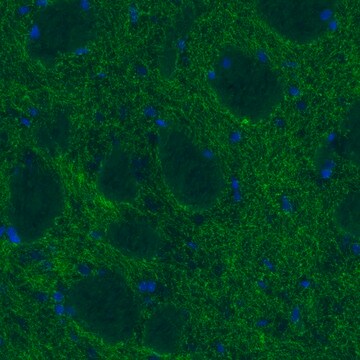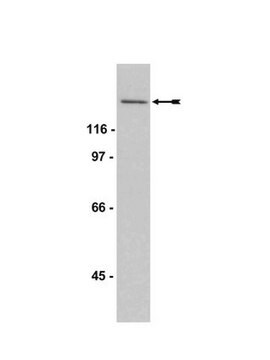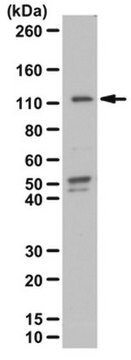ABN1675M
Anti-Nurr-1
from rabbit
Sinónimos:
Nuclear receptor subfamily 4 group A member 2, Immediate-early response protein NOT, Orphan nuclear receptor NURR1, Transcriptionally-inducible nuclear receptor, NR4A2
About This Item
Productos recomendados
origen biológico
rabbit
Nivel de calidad
forma del anticuerpo
unpurified
tipo de anticuerpo
primary antibodies
clon
polyclonal
reactividad de especies
mouse, human
reactividad de especies (predicha por homología)
rat (based on 100% sequence homology)
envase
antibody small pack of 25 μL
técnicas
ELISA: suitable
immunohistochemistry: suitable (paraffin)
western blot: suitable
isotipo
IgG
Nº de acceso NCBI
Nº de acceso UniProt
modificación del objetivo postraduccional
unmodified
Información sobre el gen
human ... NR4A2(4929)
Descripción general
Especificidad
Inmunógeno
Aplicación
ELISA Analysis: A representative lot detected recombinant Nurr-1 LBDs (Courtesy of Dr. Pierre Leblanc at McLean Hospital, Belmont, MA).
Immunohistochemistry Analysis: A representative lot detected Nurr-1 in Midbrain dopamine neurons (Leblanc, P., et. al. (2015). J Vis Exp. (102):e52963).
Western Blotting Analysis: A 1:2,000 dilution from a representative lot detected Nurr-1 in HEK293T and CHO cells overexpressed with Myc-Tagged mouse full length Nurr1/Nor1/Nurr77 (Courtesy of Dr. Pierre Leblanc at McLean Hospital, Belmont, MA).
Immunohistochemistry Analysis: A 1:250-1:2,500 dilution from a representative lot detected Nurr-1 in mouse brain tissue sections.(Courtesy of Dr. Pierre Leblanc at McLean Hospital, Belmont, MA).
ELISA Analysis: A representative lot detected Nurr-1 ligand binding domain (Leblanc, P., et. al. (2015). J Vis Exp. (102):e52963).
Western Blotting Analysis: A representative lot detected Nurr-1 in CHO cells transfected with full-length myc-tagged Nurr-1 (Leblanc, P., et. al. (2015). J Vis Exp. (102):e52963).
Neuroscience
Calidad
Immunohistochemistry (Paraffin) Analysis: A 1:50 dilution of this antibody detected Nurr-1 in mouse cerebral cortex tissue sections.
Descripción de destino
Forma física
Almacenamiento y estabilidad
Otras notas
Cláusula de descargo de responsabilidad
¿No encuentra el producto adecuado?
Pruebe nuestro Herramienta de selección de productos.
Código de clase de almacenamiento
12 - Non Combustible Liquids
Clase de riesgo para el agua (WGK)
WGK 2
Punto de inflamabilidad (°F)
Not applicable
Punto de inflamabilidad (°C)
Not applicable
Certificados de análisis (COA)
Busque Certificados de análisis (COA) introduciendo el número de lote del producto. Los números de lote se encuentran en la etiqueta del producto después de las palabras «Lot» o «Batch»
¿Ya tiene este producto?
Encuentre la documentación para los productos que ha comprado recientemente en la Biblioteca de documentos.
Nuestro equipo de científicos tiene experiencia en todas las áreas de investigación: Ciencias de la vida, Ciencia de los materiales, Síntesis química, Cromatografía, Analítica y muchas otras.
Póngase en contacto con el Servicio técnico







